► Ford’s hybrid Kuga vs rivals
► Comfy Peugeot and posh Volvo
► Which is the best family transport?
The new Kuga is Ford’s first European plug-in hybrid. How does it fare against equally-electrified versions of the Peugeot 3008 and Volvo XC40?
Pre-flight briefing: Ford Kuga PHEV
Why is it here?
The first salvo of Ford’s 2020 electrification offensive involves the third biggest seller in Europe after Fiesta and Focus. If you want one, make sure it’s not subject to the recall that highlights a fire risk associated with early builds.
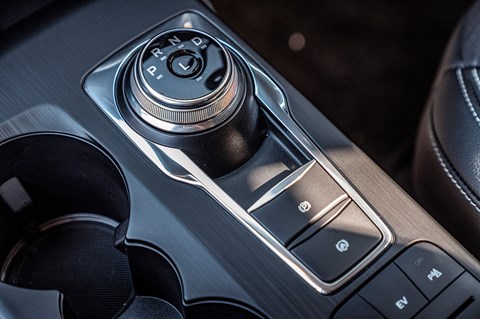
Any clever stuff?
Developed in-house, the Toyota-aping CVT gearbox manages the power delivery. New global platform is 80kg lighter than the one used by the previous Kuga. EV modes use plain English; not trying to blind us with science, refreshingly.
Which version is this?
A mid-spec Titanium with a more muted look than the ST-Line, and conventional dials instead of the 12.3-inch digital display. There’s only one PHEV power variant, unlike the Peugeot and Volvo. It works; 97.5mpg on test.
Read our Ford Kuga review
Ford Kuga PHEV: No offence, intended
The year of our apocalypse – 2020 – is also that of the PHEV. How do we know? Because the usually glacially-paced Ford has gone from merely dabbling with electrification with the Focus Electric and Mondeo Hybrid, to cranking out a variety of new electrified models in a year. The new Kuga is the first plug-in hybrid of this new range, Ford calling it ‘the most electrified model ever’.
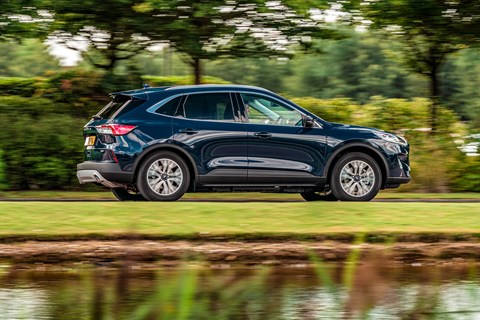
Unfortunately electrification doesn’t translate into excitement, and the Kuga’s a veritable wallflower compared with the striking 3008 and XC40 we’re testing. There’s no real drama or intrigue in this Titanium spec, and buyers should be able to expect some of that from a mid-size crossover. At best the Kuga looks like an Aston DBX… from very far away.
You won’t be amazed inside, either – Ford just hasn’t nailed that premium feel, despite other mainstream brands like Peugeot and Mazda proving it can be done. Understandably, it’s all Focus-based in here, which creates a slightly gloomy atmosphere. It’s almost as though Ford’s goal was to be merely average. At least the high-mounted Sync 3 infotainment screen is crisp and bright. Higher-spec models have digital dials instead of the two-dials-and-screen approach of our Titanium spec. Regardless of which one you go for, the power meter displays how much oomph you’re using. Titanium models also get a B&O Play audio upgrade, which is worth the money, although particularly bassy music sounds a little muddy.
As a lanky guy, I struggle with the driving position. Even pumping the seat as low as possible, I sit too high – so much so that the rear-view mirror doesn’t adjust upward enough, obscuring visibility. The seats, too, are flat and lack padding and support, even after twiddling the manual lumbar dial. Those in the rear are better catered for, with generous legroom for adults – even behind a tall driver – and plentiful headroom. The rear seat bench also reclines and can be slid fore and aft, raising boot volume from 411 litres to 581 litres. Tonnes of cubbies and big doorbins too.
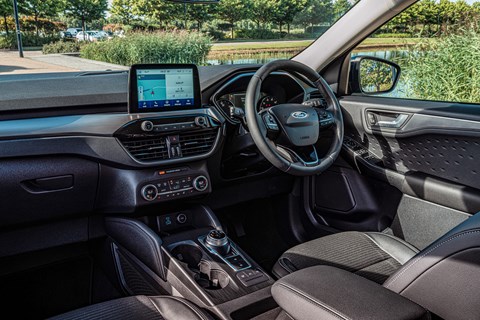
The inoffensiveness continues as you prod the starter and the hybrid Kuga starts on electric power. Like any other PHEV, the Kuga has driving modes for the hybrid powertrain but labels them in a much simpler way: EV Normal, EV Now, EV Later and EV Charge. Later holds the battery, and Charge uses the engine to top the batteries at the expense of mpg.
As you glide away, complete with a thoroughly space-age hum, you realise that – driving position aside – Ford still knows how to get driving basics right. The steering on turn-in is rubbery and has some aggressive self-centering, but there’s satisfying weight that’s missing from the Peugeot and Volvo at low speeds and it’s supremely accurate.
Ford has also proved that it is possible to make a plug-in’s brake pedal feel normal, despite mixing braking by e-motor to regenerate energy and braking by old-fashioned discs and pads. The pedal’s still not the last word in confidence-inspiring feel but you do get progressive speed reduction – unlike our other two contenders. There’s also an ‘L’ mode on the rotary gear selector that amps up regeneration from coasting.
Also, who knew that a CVT auto could be so good? Ford has somehow managed it, with the help of some serious soundproofing of its naturally-aspirated four-cylinder. Only on full throttle do you really hear a drone; under half-load acceleration there’s barely a whisper, thanks to a generous dollop of e-torque. It’s not a quick car (the Peugeot is shockingly fast by comparison) but plenty powerful enough for day-to-day life.
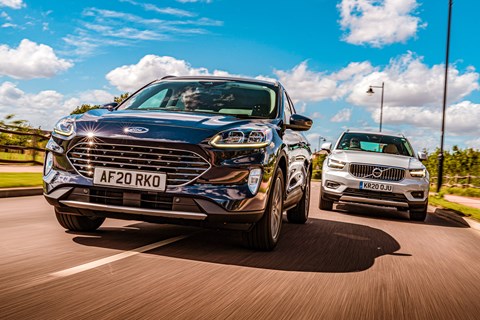
The Ford is also the most refined cruiser of the three, riding pliantly on standard 18-inch alloys with generous sidewalls in our Titanium spec, and coating lumpy roads with what feels like a memory-foam mattress topper. It’s athletic through the corners, too; there’s a touch of understeer under hard cornering but sharp changes of direction don’t unsettle it. Some of Ford’s chassis magic is alive and well, even in one of its less dynamic cars.
The word that instantly springs to mind with the Kuga is balanced – in many ways a good quality, but it’s delivered here at the expense of excitement. There’s still some welcome innate Ford-ness to how it feels behind the wheel, and it’s roomy inside for the whole family, it’s just that it goes about its business in such an uninspiring way. Would this be a car to show off to your friends and family? Not really. Would it slot into your life and just get on with being part of it without any fuss? Without a doubt.
Pre-flight briefing: Volvo XC40 Recharge
Why is it here?
If any maker has been ahead of the curve with plug-in hybrids over the last few years, it’s Volvo. The XC40 is the brand’s smallest SUV, and one the CAR team loves for its Scandi cool, sophisticated cockpit and safety brilliance.
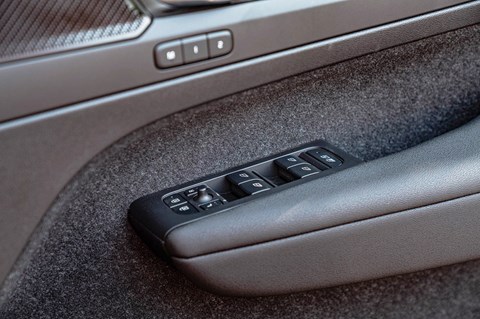
Any clever stuff?
Nothing really PHEV specific, but the XC40 uses carpet felt and door inlays produced from recycled plastic. The ‘Care by Volvo’ subscription service can deliver an XC40 to your door with very little effort.
Which version is this?
The more powerful of two XC40 PHEV variants and a victim of Volvo’s now rather confusing naming structure, as it ditches Twin Engine for the Recharge moniker that the incoming full EV will also use. All-out Inscription Pro specification slathers on the luxury with little details like a crystal gear selector.
Read our Volvo XC40 Recharge hybrid review
Volvo XC40 Recharge: plugged in before it was cool
Ford and Peugeot are only just getting their act together with plug-in hybrids, but Volvo is well and truly in its stride, offering at least one per model and quietly deleting diesel in the process. In fact, the Swedish maker is entering phase two of its electrification era, and has now renamed its plug-ins Recharge, from Twin Engine – though the Recharge name also confusingly applies to pure EVs.
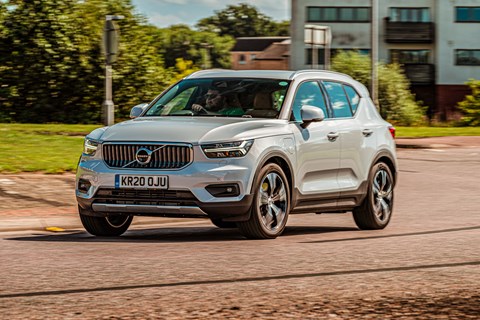
Volvo’s ‘tough little robot’ (the words of former Volvo exterior designer Ian Kettle) has bags of character, its boxy silhouette giving off such ultra-modern vibes, with creases in all the right places and Volvo’s now ubiquitous ‘Thor’s Hammer’ light signature cutting crisp lines through the front end. Volvo’s baby crossover is dripping with cool.
Get inside and the XC40 continues to impress, as its cockpit is in a whole other league in terms of quality, particularly compared with the austere Ford. The skinny, super-supportive seats (in a tasty caramel leather in this Inscription Pro model), the Orrefors crystal gear selector, the ‘Since 1955’ etchings on the seatbelts and the contoured door inlays… all of these little details in such a well-built interior make the XC40 feel truly special. It does practical too, with the largest boot on test.
Compared with the Kuga and 3008’s infotainment screens, the Sensus Connect system has iPad-like reflexes and is pin sharp, although the selection screens either side of the main home screen are more than a little baffling. While we complain about Peugeot putting literally everything behind a menu, Volvo does the exact opposite and shows all of your possible infotainment and vehicle controls on a single platter, making it tricky to find what you want at a glance. The hybrid powertrain management controls are bundled right next to all of the XC40’s safety tech, for instance, making it easy to switch off blindspot monitoring when you’re actually aiming for the Battery Hold button. Air-con controls are also relegated to a couple of touchscreen taps (just like the Peugeot), rather than physical dials and switchgear. But Volvo’s take on button reduction works better than Peugeot’s, despite its flaws.
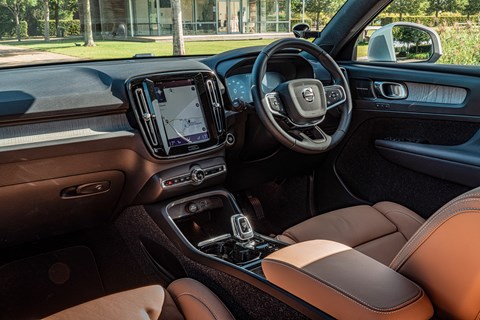
There’s an odd niggle with that crystal gear selector, though: why push or pull the lever twice to select Drive or Reverse? You get used to it if it’s the only car you drive, but it feels like an unnecessary complication that can be confusing when you’re mid-manoeuvre and in a hurry.
Volvo has opted for a three-cylinder turbo as the Recharge PHEV’s combustion engine rather than the four-cylinders used by its Giant Test rivals. The engine is shrouded in soundproofing to the point that even at high revs the hushed ambience inside isn’t upset – this really is a refined place in which to spend time isolating yourself from the world. And when you do hear it, that classic gargly engine note is another welcome quirk of an already quirky car.
The Volvo’s engine is the keenest to wake from EV mode of the three cars, as the threshold for electric power (shown on the swooping semi-circle power meter split with a lightning bolt and drop of petrol) is easy to breach even when driving around town. Hoof it and the powertrain deftly manages your throttle requests – with much less latency than the Peugeot, and it’s faster than the Kuga.
Like the Peugeot, the XC40 doesn’t enjoy being driven hard but in an entirely different way – there are hard edges to the driving dynamics that don’t translate well if you’re in the mood for fun. The biggest of these buzzkills is the brakes; the pedal is wired, firm and ready to snap at you like a Rottweiler if you so much as look at it the wrong way. It’s so sensitive that just a moderately firm prod of the brake pedal can trigger the anti-lock brake system.
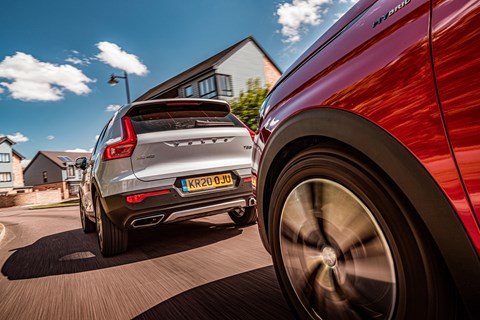
But there’s an impressive chassis here, even if it feels sullied by the PHEV’s additional weight. Bodyroll is minimal, with the blocky XC40 cornering flatter than either of these Giant Test rivals when the going gets twisty. But the ride is firm to the point of the Volvo feeling brittle in this specification, with the taut suspension and large wheels on this Inscription Pro model sharpening potholes and road imperfections at higher speeds. Turn in with some vim and the steering – smooth, light and accurate at low speeds – starts to feel soggy as the XC40 washes into understeer with an accompanying squeak from the over-stressed front tyres. You’ll need to step up to an XC60 or S60 saloon if you want all-wheel drive from your hybrid Volvo.
While it feels fast enough and super refined, there’s also a pent-up harshness to the ride that’s hard to ignore. So this is no dynamic masterclass, but what the Volvo concentrates on is making you feel special when you’re sitting inside. The result is this is a much nicer place to spend your journeys than either the Ford or the Peugeot.
Pre-flight briefing: Peugeot 3008 HYbrid4
Why is it here?
Peugeot’s mid-size SUV started off Peugeot’s design renaissance back in 2016, with chunky styling outside and a dramatic interior. Hybrids recently joined the range, as part of Groupe PSA’s push for all its brands to go eco.
Any clever stuff?
The EMP-2 platform that underpins it is used by PSA’s larger cars: everything from Peugeot’s 508 and 5008 to Citroën’s C5 Aircross and the DS 7 Crossback. There’s a motor on each axle here for electric all-wheel drive.
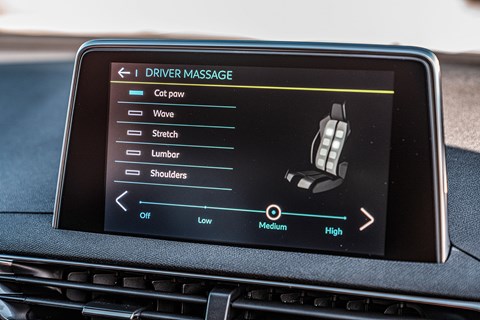
Which version is this?
The flashy, all-out GT riding on 19-inch alloys. Peugeot is unusual in offering massage seats in a car of this type and price, complete with the slightly disconcerting ‘cat paw’ setting. This HYbrid4 has 297bhp; 222bhp front-drive version also available.
Read our Peugeot 3008 HYbrid4 review
Peugeot 3008 HYbrid4: rock ‘n’ roll design and dynamics
Even four years after its first reveal, the 3008 still looks bonkers inside and out. If you want pizzazz, Peugeot’s second largest crossover is the place to be, but only since April this year has the SUV that made the French Lion cool again plugged in. Not that you’d know: your only marker is a ‘HYbrid4’ badge on the rear end and an extra filler cap for the charging port.
Get into the Peugeot after the dowdy Ford and you’ll want what some of Peugeot’s interior designers have been smoking – there’s real imagination and flair here. It helps that the driving position is far superior to the Ford’s and on par with the Volvo’s, and while the Volvo too offers supportive seats, the Peugeot’s are supremely soft and benefit from some intricate stitching to differentiate this GT model.
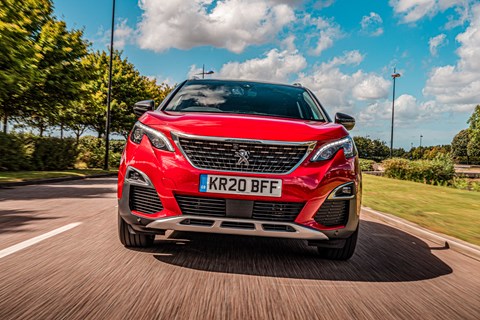
Just like the exterior, there’s very little to say you’re driving the hybrid variant: a lightning bolt button for managing the hybrid powertrain, and an extra graphic in the stylish instrument display that shows power flow, are your only internal visual cues. This one even has an optional three-pin 230-volt socket included in the rear.
Behind that striking and stylish façade, though, there are some niggles. Our test car’s dashboard materials are let down by some slightly rough-edged fittings, the cupholders in the centre are small and too close together, and the infotainment screen feels its age. Other gripes are less Peugeot-specific and just inherent PSA annoyances; the screen is a little low-res and the system that powers it is well below par: slow at the best of times, downright uncommunicative at the worst of times, and with air-con controls hidden behind a digital menu rather than physical controls that you can feel for without taking your eyes from the road. The start button is also annoyingly laggy – you really have to press hard and hold to get a response, no simple tap to get going quickly here.
But when you do get going, you really can go – this thing is fast when you flick the drive mode rocker switch from Hybrid to Sport. It sends 297bhp to all four wheels, and there’s so much oomph that it can keep up with the likes of a Fiesta ST in its most aggressive drive mode, upping the top speed to 149mph (in electric, the top speed is limited to 84mph).
But reach a corner at speed and the Peugeot starts to unravel dynamically; the hexagonal steering wheel feels supremely light at low speeds and uncommunicative at higher ones, and the auto ‘box can be indecisive in its actions depending on your throttle inputs – Ford’s CVT-enabled powertrain feels far smoother and more responsive by comparison. The petrol engine itself sounds unrefined from the outside when it kicks in at idle, to the extent that you might mistake it for a diesel.
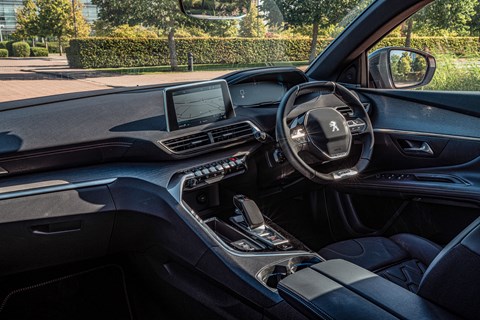
It’s all so soft and remote on the move, with all the comfort pros and dynamic cons that suggests. Bodyroll, for example, is excessive, so much so that hard cornering can make the 3008 lurch even after the corner is in your rear-view mirror. The squidgy-ness continues with the brakes, which are defined by one of the softest pedals I’ve ever experienced. It feels like there’s a good couple of inches of travel where little braking occurs, and the brakes don’t feel all that strong if you press harder. It’s far from comforting, especially in those heart-stopping moments when you need it.
Thankfully, the engine is much quieter on the inside, and the ride is super plush with its spongy tyres, making the 3008 a delight for low-effort cruising and soaking up meaty urban potholes. Add in a very satisfying massage seat for the driver and you’ve got a plug-in hybrid SUV that suits a laid-back driving style very well indeed.
Shame, then, that the Peugeot provides less room to sprawl out and relax than today’s rivals. The cockpit surrounds you as a driver, with a high centre console and bulky door inlays, and there’s only just enough legroom in the back for adults. GT models get a panoramic sunroof as standard that cuts into headroom, and the boot volume takes a cut for the hybrid, dropping substantially from 520 litres to 395. A Nissan Juke has a bigger boot than that.

Style over substance? Well, you’d definitely be proud to have it on your driveway for a start. Park the Peugeot 3008 next to the Ford and the two are like chalk and cheese. The infotainment is a pain, and the chassis is downright belligerent if you want a bit of fun after the school run. But treat it like an over-padded sofa that you sink into after a hard day at the office and just cruise home in and the Peugeot starts to make sense.
Final reckoning: left brain trumps right brain
The hybrid-powered family SUV is one of the most vanilla car choices you can make, but buyers still demand some visual flair and satisfying driving dynamics to go with the eco-cred and versatility. None of our contenders strikes the perfect balance, so our result carefully weighs the strengths and weaknesses of three imperfect crossovers.
Given all are plug-in hybrids, we also paid particular attention to fuel economy figures. All were fully charged, all did the same amount of test miles and, on our sunny fuel-test day, we had the air-con working hard – just like an owner would.
The Peugeot was most likely to trigger its engine in hybrid mode, hence the less than stellar 34.1mpg economy during that real-world testing, with the Volvo burping to life about half as often at a standstill – the Swede returned 62.7mpg. The Kuga, however, maintained e-mode longest, looking on silently at its Giant Test rivals and achieving the highest test mpg, a cracking 97.5mpg.
The Peugeot takes last place, even though there’s still much to enjoy about it. The 3008 continues to be a truly striking piece of design inside and out (and the incoming facelift for 3008 and 5008 will sharpen it further), it’s hot-hatch fast and, if speed’s not so crucial, there’s a slower and cheaper version. But whichever one you choose, it’s a fun-sponge dynamically. Bad for keener drivers, sure, but if you want to cruise about gently, there’s little to dislike here.
For premium posing power, the Peugeot may shout about it and put on a great show, but the quiet and cool Volvo actually does it better. Versus these rivals, its interior is on another level for poshness, and as low-stress eco transport, it’s hard to do better for around £40k, though we’d prefer a smoother ride.
A polar opposite of the Volvo’s Scandinavian cool, the Kuga leaves you just plain cold when you climb inside. It’s much the same as most recent Fords inside: entirely forgettable. And yet we can’t ignore how well the Kuga does everything else. It has the best of both worlds when it comes to dynamics, being more comfortable than the Volvo, hushed on the move at any speed, with a powertrain that’s responsive, quick and as smooth as it needs to be. It’s best to drive too. That basic interior is also the most practical for rear space and cubbies for your family’s bits and bobs.
The Ford isn’t particularly exciting but, as functional and thrifty family transport that still delivers a dose of dynamic entertainment, the Kuga would be our pick. Vanilla ice cream might not have much novelty value, but sometimes it hits the spot just fine.
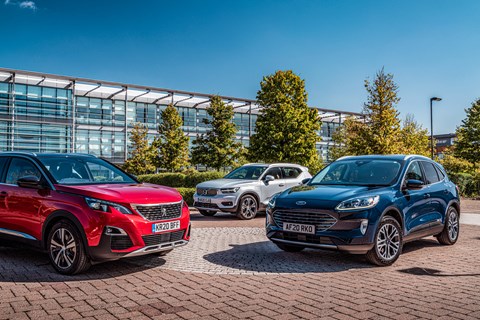
Ford Kuga PHEV vs Peugeot 3008 HYbrid4 vs Volvo XC40 Recharge: verdict
Ford Kuga
Smooth to drive, roomy inside and the best value here, but a vanilla choice
★★★★
Volvo XC40
An ultra-modern isolation chamber, but feels far too sharp ands far from cheap
★★★
Peugeot 3008
Quick and comfortable, but stodgy, expensive and the least practical on test
★★★
Check out more CAR comparison tests here